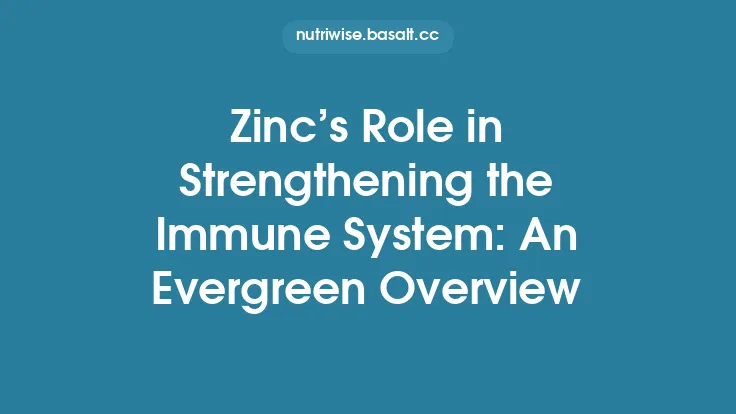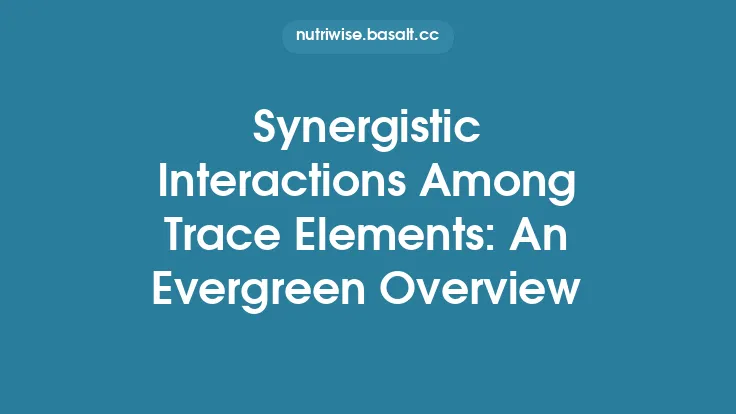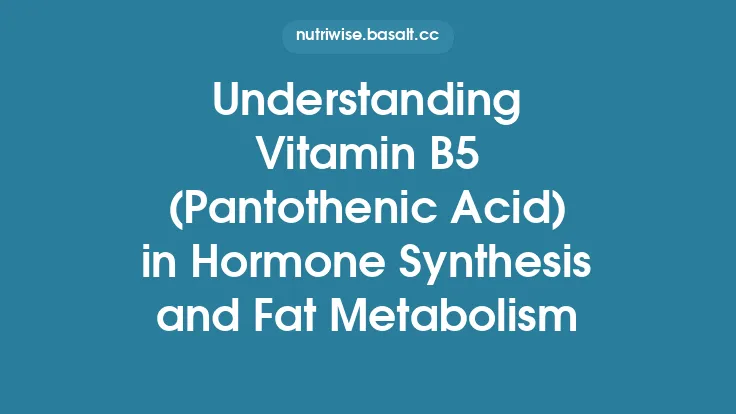The thyroid gland is a small, butterfly‑shaped organ that exerts a disproportionate influence on metabolism, growth, and development. While iodine is the most celebrated micronutrient in thyroid hormone production, selenium occupies a pivotal, yet often underappreciated, niche in the biosynthetic cascade. Selenium’s involvement is not limited to a single step; it permeates the entire process—from the generation of the hormone precursors to the fine‑tuning of their biological activity. Understanding these mechanisms provides a foundation for clinicians, researchers, and students who seek a comprehensive view of thyroid physiology that transcends the more commonly discussed dietary and supplementation topics.
Thyroid Hormone Biosynthesis: A Brief Overview
Thyroid hormone synthesis begins with the active uptake of iodide (I⁻) into follicular cells via the sodium‑iodide symporter (NIS). Within the colloid, iodide is oxidized to iodine (I⁰) by thyroid peroxidase (TPO), a heme‑containing enzyme that also catalyzes the iodination of tyrosine residues on thyroglobulin (Tg). The iodinated tyrosines—monoiodotyrosine (MIT) and diiodotyrosine (DIT)—undergo coupling reactions to form the prohormones thyroxine (T₄) and triiodothyronine (T₃). After proteolytic cleavage of Tg, T₄ and T₃ are released into the circulation, where T₄ serves primarily as a pro‑hormone and T₃ as the biologically active form.
While this outline highlights the central role of iodine and TPO, it omits a critical set of enzymes that depend on selenium for their catalytic activity. These selenoproteins ensure that the thyroid hormone pool is correctly balanced, that excess reactive oxygen species (ROS) generated during hormone synthesis are neutralized, and that the final hormone products attain their proper conformation and function.
Selenoproteins Central to Hormone Production
Selenium is incorporated into proteins as the amino acid selenocysteine (Sec), often referred to as the 21st amino acid. In the thyroid, three families of selenoproteins are of particular relevance:
- Iodothyronine Deiodinases (DIOs) – Enzymes that remove iodine atoms from T₄ and T₃, thereby activating or deactivating thyroid hormones.
- Glutathione Peroxidases (GPxs) – Antioxidant enzymes that mitigate hydrogen peroxide (H₂O₂) generated during iodide oxidation.
- Thioredoxin Reductases (TrxRs) – Redox regulators that maintain the reduced state of thioredoxin, a co‑factor for several thyroid‑related reactions.
Each of these selenoproteins contains a Sec residue at the active site, which confers a unique nucleophilicity that is essential for catalysis under physiological conditions.
The Deiodinase Family: Converting T₄ to T₃
Three deiodinases—DIO1, DIO2, and DIO3—mediate the removal of iodine atoms from the inner (5′) or outer (5) positions of the phenolic ring of thyroid hormones. Their actions determine the local and systemic availability of active T₃:
- DIO1 is expressed in the liver, kidney, and thyroid, performing both outer‑ring (5′) and inner‑ring (5) deiodination. It contributes to circulating T₃ levels and to the clearance of reverse T₃ (rT₃).
- DIO2 is the primary source of intracellular T₃ in the brain, pituitary, brown adipose tissue, and skeletal muscle. By catalyzing outer‑ring deiodination of T₄, DIO2 ensures that target cells receive adequate T₃ for metabolic regulation.
- DIO3 inactivates thyroid hormones through inner‑ring deiodination, converting T₄ to rT₃ and T₃ to T₂. This enzyme is crucial during fetal development and in tissues where hormone excess must be curtailed.
All three deiodinases share a conserved Sec‑containing active site that participates in a selenenyl‑iodide intermediate during the deiodination reaction. The high nucleophilicity of Sec enables rapid attack on the carbon‑iodine bond, a step that would be energetically unfavorable for cysteine‑based enzymes.
Selenocysteine Incorporation: The Unique Genetic Code
The biosynthesis of selenoproteins is a remarkable example of translational recoding. The UGA codon, normally a stop signal, is redefined as a Sec codon in the presence of a specific mRNA structure called the selenocysteine insertion sequence (SECIS) element. The process involves:
- Selenophosphate Synthetase (SPS2) – Generates selenophosphate, the activated selenium donor.
- tRNA^[Sec] – A specialized tRNA that recognizes UGA and is charged with Sec via a multi‑step pathway involving selenophosphate.
- SECIS‑Binding Protein 2 (SBP2) – Binds the SECIS element and recruits the Sec‑tRNA to the ribosome.
This intricate machinery ensures that the Sec residue is precisely positioned within the active site of deiodinases, GPxs, and TrxRs. Any disruption in SECIS function, tRNA^[Sec] maturation, or selenium availability can impair selenoprotein synthesis, with downstream effects on thyroid hormone homeostasis.
Regulation of Selenium‑Dependent Enzymes in the Thyroid
Selenoprotein expression is tightly regulated at transcriptional, translational, and post‑translational levels:
- Transcriptional Control – The promoters of DIO genes contain thyroid hormone response elements (TREs) that enable feedback regulation. Elevated T₃ can suppress DIO1 transcription while stimulating DIO2, creating a fine‑tuned balance.
- Translational Hierarchy – In conditions of limited selenium, the cell prioritizes synthesis of essential selenoproteins (e.g., GPx1) over others (e.g., DIO3). This hierarchy is mediated by differential affinity of SECIS elements for SBP2.
- Post‑Translational Modifications – Phosphorylation of DIO2 at specific serine residues modulates its activity and half‑life, allowing rapid adaptation to metabolic demands.
These regulatory layers ensure that the thyroid can adjust hormone activation and inactivation rates in response to physiological cues such as cold exposure, fasting, or developmental stage.
Interplay Between Selenium and Iodine in Hormone Synthesis
Although selenium and iodine serve distinct biochemical roles, their interaction is essential for efficient hormone production:
- Oxidative Coupling – The iodination of Tg by TPO generates H₂O₂ as a by‑product. GPxs and TrxRs, both selenium‑dependent, detoxify this H₂O₂, preventing oxidative damage to the follicular epithelium and preserving TPO activity.
- Redox Balance – Adequate selenium maintains a reduced intracellular environment, which is required for the proper folding of Tg and for the activity of TPO’s heme group.
- Hormone Conversion – Iodine provides the substrate (T₄) that deiodinases act upon. Without sufficient selenium, deiodinase activity declines, leading to an accumulation of T₄ and a relative deficiency of T₃, despite normal iodine status.
Thus, the thyroid’s functional integrity hinges on a synchronized supply of both micronutrients, each supporting distinct but interdependent steps in the biosynthetic pathway.
Pathophysiological Insights: When Selenium Pathways Are Disrupted
Genetic or acquired disturbances in selenium metabolism can manifest as altered thyroid hormone profiles, even in the absence of overt iodine deficiency:
- SECIS Element Mutations – Rare polymorphisms that weaken SECIS binding reduce the efficiency of Sec insertion, leading to lower deiodinase activity and a shift toward higher rT₃ levels.
- Selenoprotein Gene Variants – Single‑nucleotide polymorphisms (SNPs) in DIO2 (e.g., Thr92Ala) have been linked to altered enzyme kinetics and are associated with subtle changes in basal metabolic rate and susceptibility to certain neuropsychiatric conditions.
- Autoimmune Interference – In autoimmune thyroiditis, inflammatory cytokines can down‑regulate the expression of GPxs, increasing oxidative stress and potentially impairing TPO function.
These examples illustrate that selenium’s role extends beyond simple nutritional adequacy; it is integral to the molecular fidelity of thyroid hormone synthesis and regulation.
Research Frontiers and Emerging Technologies
Recent advances are expanding our understanding of selenium’s thyroidal functions:
- CRISPR‑Based Gene Editing – Targeted knockout of DIO genes in animal models has clarified isoform‑specific contributions to tissue‑specific T₃ availability.
- Selenoprotein Imaging – Novel fluorescent Sec analogs enable real‑time visualization of deiodinase activity in live cells, offering insights into dynamic hormone conversion.
- Metabolomics – High‑resolution mass spectrometry is uncovering previously unrecognized selenium‑dependent metabolites within the thyroid, suggesting additional layers of regulation.
These tools promise to refine therapeutic strategies that may one day modulate specific selenoproteins without altering systemic selenium status.
Practical Takeaways for Clinicians and Researchers
- Molecular Focus – When evaluating thyroid disorders, consider the possibility of altered selenoprotein function, especially in patients with atypical hormone patterns (e.g., high T₄/low T₃) that cannot be explained by iodine status alone.
- Diagnostic Nuance – Measurement of serum rT₃, alongside T₄ and T₃, can provide indirect clues about deiodinase activity and, by extension, selenium‑dependent processes.
- Research Design – Studies investigating thyroid physiology should control for both iodine and selenium levels, as their interaction can confound outcomes related to hormone synthesis and metabolism.
- Therapeutic Exploration – Emerging pharmacologic agents that selectively enhance DIO2 activity are under investigation for conditions such as hypothyroidism resistant to conventional levothyroxine therapy.
By appreciating the intricate, selenium‑driven mechanisms that underlie thyroid hormone synthesis, professionals can adopt a more nuanced perspective that transcends the simplistic view of micronutrient supplementation and moves toward targeted, mechanistic interventions.





